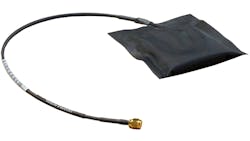This file type includes high-resolution graphics and schematics when applicable.
Wearable antennas were once considered a novelty. But now, with more wireless sensors finding their way into Internet of Things (IoT) applications, wearable antennas are increasingly necessary. Work performed by professors from the University of Pisa (Italy) and the University of Ghent (Belgium) explored the materials and design configurations required to realize wearable antennas for use at VHF and UHF bands.
The professors note that wearable antennas have served in applications for military and professional-mobile-radio (PMR) communications for law-enforcement professionals, and that the VHF and UHF bands are well-suited for wearable antenna applications in health-monitoring systems and security systems. Choice of materials for the wearable antennas must provide unobtrusive configurations that are light in weight and flexible to allow freedom of movement with the body parts they surround, while also delivering compact structures as a function of the operating frequencies.
The research team points out that conventional VHF antennas, as related to the wavelengths of these lower frequencies, are somewhat bulky. They require miniaturization techniques to adapt antennas at VHF and UHF bands for use in wearable applications. A wearable antenna’s design should also consider the postures and movements of the wearer and how those movements will affect the radiation pattern and impedance of the wearable antenna.
To minimize the effects of mismatches due to body movements, many body-worn antennas are designed with broadband responses to overcome the effects of the dielectric constants of skin and muscle tissue on wearable antenna patterns and responses. The professors detailed several successful instances of helmet-worn antennas at VHF and UHF for public-safety professionals, including fire fighters and police officers. These antennas must often compete with other devices, such as helmet-worn cameras, in the same operating environment.
Much of the team’s research focused on designing wideband antennas at VHF and UHF that are compact enough to be wearable, when compared to average human body size, without sacrificing electrical performance. One example is a vest-worn, flexible double-loop for use in the 30- to 80-MHz VHF range. In this design, the conducting strips are integrated with nonconducting textile material to form a vest that fits an average size adult torso. Additional antenna designs reached frequencies to about 600 MHz for personal communications applications, some in the form of straps that can be worn over a shoulder or as part of a carry bag.
Other efforts revolved around wearable antennas for radio-frequency-identification (RFID) applications at UHF from 840 to 960 MHz, and how the RFID tags can be made with compact antennas small enough to be worn unobtrusively on wrists or over different forms of clothing. Additional antenna designs were helmet-mounted antennas for use from 500 to 2000 MHz, and a whole-body antenna that could be made into a flak jacket, pants, and shoes for use from 20 to 30 MHz for military and public-safety personnel. See “Wearable Antennas for Off-Body Radio Links at VHF and UHF Bands,” IEEE Antennas & Propagation Magazine, October 2015, p. 30.
Looking for parts? Go to SourceESB.
About the Author
Jack Browne
Technical Contributor
Jack Browne, Technical Contributor, has worked in technical publishing for over 30 years. He managed the content and production of three technical journals while at the American Institute of Physics, including Medical Physics and the Journal of Vacuum Science & Technology. He has been a Publisher and Editor for Penton Media, started the firm’s Wireless Symposium & Exhibition trade show in 1993, and currently serves as Technical Contributor for that company's Microwaves & RF magazine. Browne, who holds a BS in Mathematics from City College of New York and BA degrees in English and Philosophy from Fordham University, is a member of the IEEE.

